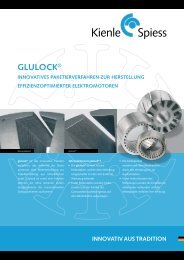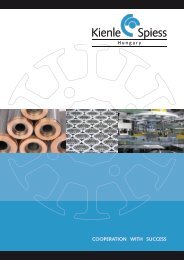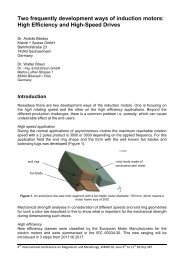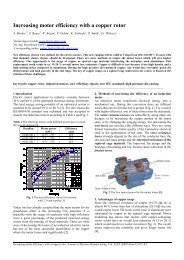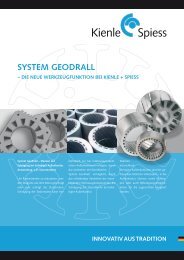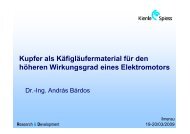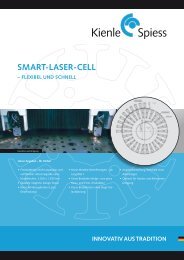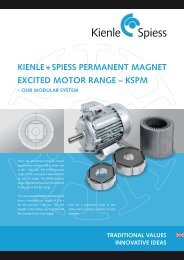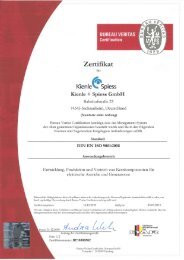Copper rotors - Kienle + Spiess
Copper rotors - Kienle + Spiess
Copper rotors - Kienle + Spiess
You also want an ePaper? Increase the reach of your titles
YUMPU automatically turns print PDFs into web optimized ePapers that Google loves.
Losses (W)<br />
1000<br />
900<br />
800<br />
700<br />
600<br />
500<br />
400<br />
300<br />
200<br />
100<br />
0<br />
<strong>Copper</strong> <strong>rotors</strong><br />
asynChronous motors with <strong>Copper</strong> <strong>rotors</strong><br />
– greater effiCienCies for smaller motors<br />
Cu 1.1 kW Al 1.1 kW<br />
50 Hz<br />
n Friction losses<br />
n <strong>Copper</strong> losses rotor (I2R losses)<br />
n Eddy-current losses<br />
n Core losses<br />
n <strong>Copper</strong> losses stator/stator (I2R losses)<br />
• Lower operational costs for electrical<br />
motors with copper <strong>rotors</strong> (up to 6%<br />
energy saving potential for 0.75 kW<br />
motors<br />
• Higher efficiency with the same or<br />
shorter cores lengths<br />
• Lower operating temperature<br />
• Increased life of the bearings due to a<br />
lower rotor temperature<br />
• eco-friendly, because energy-saving<br />
Cu 5.5 kW Al 5.5 kW<br />
The advantage by using copper is based<br />
on the reduced specific resistance of<br />
copper, compared to the one of alumi-<br />
nium. Due to this fact, the I 2 R losses on<br />
the motor reduces significant.<br />
traditional values<br />
innovative ideas
ConduCtivity <strong>Copper</strong><br />
Overall loss (W)<br />
500<br />
480<br />
460<br />
440<br />
420<br />
400<br />
380<br />
Other manufacturer <strong>Kienle</strong> + <strong>Spiess</strong><br />
75 years of experience in die-casting<br />
technology – the highest quality of<br />
cast <strong>rotors</strong>.<br />
Die-casting of copper requires a high<br />
degree of know-how and process<br />
reliability for ensuring a very high cast<br />
quality. The porosity in the end ring<br />
poses a bigger challenge to the balancing<br />
of the <strong>rotors</strong> than to its electrical power.<br />
The quality of the copper <strong>rotors</strong> from<br />
<strong>Kienle</strong> + <strong>Spiess</strong> is extremely high – po-<br />
rosity < 1%.<br />
~10%<br />
58 56 50 45<br />
Conductivity (m/W · mm 2 )<br />
www.kienle-spiess.com<br />
High melting temperature of copper<br />
compared to aluminium as well as their<br />
different viscosity (Cu: 3,9 mNs/qm,<br />
Al: 2,5 mNs/qm) make high demands<br />
on the casting process and result in a<br />
rapid wear of the active mould parts.<br />
The die-casting material weight is<br />
between 15 kg and maximum 25 kg,<br />
which will be covered by middle of this<br />
year.<br />
n @20°C<br />
n @100°C<br />
The excellent die-casting quality and the application of pure copper, are reducing<br />
additionally the copper rotor losses.<br />
Rotor Ø<br />
62<br />
70<br />
80<br />
90<br />
103<br />
115<br />
120<br />
135<br />
IEC size<br />
80/2<br />
90/2<br />
100/2<br />
132/2<br />
160/2<br />
71/4<br />
80/4<br />
90/4<br />
100/4<br />
112/4<br />
Many copper <strong>rotors</strong> available on stock.<br />
Please request for.<br />
All geometries of slot shapes can be<br />
used for copper die-casting.<br />
71/6<br />
80/6<br />
90/6<br />
100/6<br />
112/6<br />
www.artistic.de



